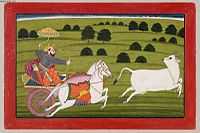Haripur Guler
| Haripur Guler Haripur | |
|---|---|
| village | |
 Haripur Guler | |
| Coordinates: 32°00′N 76°10′E / 32.0°N 76.16°ECoordinates: 32°00′N 76°10′E / 32.0°N 76.16°E | |
| Country |
|
| State | Himachal Pradesh |
| District | Kangra |
| Languages | |
| • Official | Hindi |
| Time zone | IST (UTC+5:30) |
| PIN | 176028(Haripur),176033(Guler) |
Haripur is a township in Kangra district in the Indian state of Himachal Pradesh. Haripur Guler are twin townships carrying the heritage of Guler Riyasat. A river separates the two towns which further makes Pong wetland, a Ramsar Wetalnd Site, home to a large number of migratory birds in winters because of marshes and the presence of irrigated private land. On the hills of Haripur, there is a ruined fort which was built by Raja Hari Chand, which is the second fort built by him after Kangra (Nagarkot) Fort. The caves and some temples built by the king are still there,of great heritage and cultural importance,left at the mercy of god and weather which damaging them like the damaged road of the area in its periphery. On the other side of Haripur town, is Guler which has a narrow gauge railway station connected from Pathankot station to Jogindernagar station. Formerly very prosperous and having a pool of talent, the township is now not able to provide jobs to its youngsters, forcing them to leave or to seek some informal job. The area can become a pool of the jobs if state and centre authorities will look into the potential of the area and its socio-cultural importance.
History
Haripur was famous as the cradle of the Kangra paintings.
Geography
Haripur is located at 32°00′N 76°10′E / 32.0°N 76.16°E.[1] It has an average elevation of 551 metres (1811 feet).
Demographics
It has an average population of approximate 3000 peoples.Guler Paintings

Of the hill states Guler has the longest tradition in the art of painting. During the rule of Dalip Singh (1645–1743) artists were working at Haripur Guler. However it was during the reign of Govardhan Chand (1743–1773) that an active school of painting developed at Haripur Guler. There are numerous portraits of this Raja in the Chandigarh Museum.[2] It is Guler which is the birthplace of Kangra paintings. Govardhan Chand's son Prakash Chand (1773–1779) continued the patronage of artists. His son Bhup Chand (1790–1826) also had artists working under him. Painting in Guler continued right up to the close of the 19th century.
The art of Guler style painting flourished in families with distinguishable styles and techniques, most significant amongst them were that of Pandit Seu of Guler, who died in about 1740, and his sons, the remarkable Nainsukh and Manaku. Later while Manaku worked at Guler, Nainsukh migrated to Jammu.[3]
Guler painting is marked by liquid grace and delicacy. The drawing is delicate and precise. The colours which emphasize cool blues and greens are handled with skill.
References
- ↑ Falling Rain Genomics, Inc - Haripur
- ↑ Chandigarh Museum - Kangra paintings
- ↑ Hindu Hill Kingdoms V&A Museum
External links
| Wikimedia Commons has media related to Guler style. |